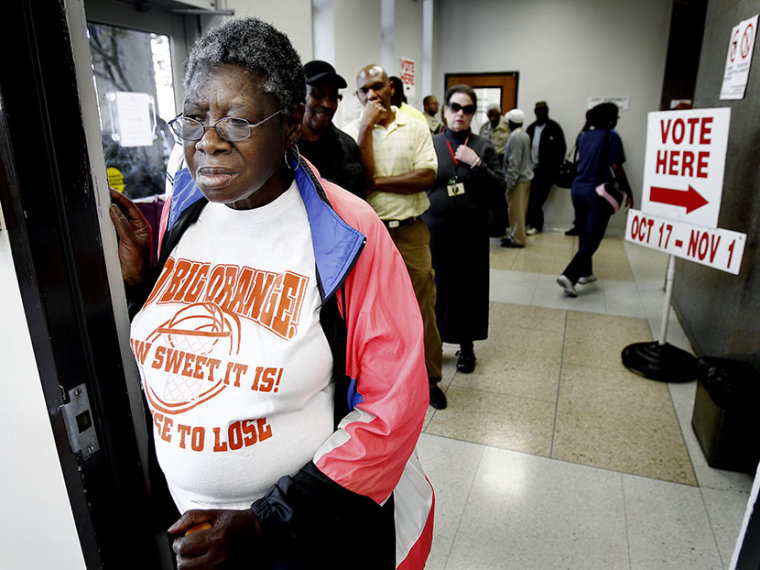Voting rights advocates are testing whether a little-used provision of the Voting Rights Act could limit the damage of the Supreme Court ruling that struck down a key part of the landmark civil rights law.
Hours after the Supreme Court's verdict was announced, representatives for the state of Texas celebrated its demise by announcing that they would move ahead with restrictive voting law changes that will disproportionately disenfranchise minorities. Those changes were previously blocked by the Justice Department, through a part of the Voting Rights Act the forces jurisdictions with a history of discrimination in voting to submit their election law changes to Washington in advance, often referred to as "preclearance," under Section 5. Preclearance prevented discrimination in advance, rather than relying on drawn out litigation that might not be resolved until long after ballots are cast.
Section 4 of the Voting Rights Act, which the high court struck down as unconstitutional, determined which jurisdictions were covered by that requirement. But Section 3 of the Voting Rights Act allows the federal government to subject jurisdictions with recent records of deliberate discrimination to the preclearance requirement. With Congress polarized and unlikely to come together to fix Section 4's coverage formula, Section 3 could become the primary tool for the Justice Department and voting rights activists seeking to patch the gaping hole left by the Supreme Court's verdict. Travis Crum, now a clerk for federal judge David S. Tatel, laid out this approach in an article for the Yale Law Journal in 2010, anticipating that the Supreme Court would someday strike down part of the Voting Rights Act. Crum called Section 3 the Voting Rights' Act's "secret weapon."
Related: How Section 5 stopped a modern day 'poll tax'
Voting rights advocates are already putting the Section 3 strategy to the test. Last Tuesday, attorneys representing the Texas branches of the NAACP, the Texas Legislative Black Caucus, and Democratic State Senator Wendy Davis in a legal battle with the state over Texas' redistricting plan asked a federal court to place the entire state of Texas back under preclearance in accordance with Section 3.
"What the court found in the case as a factual matter, their findings were that the congressional map and the senate map were both intentionally discriminatory," says Gerald Hebert, an attorney with the Campaign Legal Center who represents the groups who filed the request. "That kind of intentional discrimination violates the 14th and 15th amendments."
That high standard of proof is also part of what limits the effectiveness of Section 3 as a replacement for Section 4. To impose preclearance on a jurisdiction not covered by the now-defunct Section 4 formula, you have to prove that officials intended to discriminate. Under the old formula, all that had to be proven was that the election law changes would have discriminatory effects—precisely because most people are smart enough to hide when they're deliberately trying to discriminate.
In Texas, state officials weren't that smart. Nevertheless, the requirement that deliberate discrimination be proven means that it will be very difficult to subject states that try to disenfranchise minority voters to preclearance, because all they need is a superficial "race-neutral" reason for making the change.
"What you're likely to see in states where these actions are brought is states trying to avoid an adverse Section 3 ruling by saying, our real intent here is to hurt Democrats. Since that's our intent, that's not a racial intent and that's not forbidden by the Constitution," says Brenda Wright, a legal expert with liberal think tank Demos. Judges might not subject jurisdictions to preclearance even if deliberate discrimination is proven, or they might do so only in areas related to the discriminatory policy.
Related: It begins: Republicans rush to change voting laws
Wright pointed msnbc to a 2004 Section 2 case in Massachusetts where officials said they were just trying to protect incumbents when they redrew legislative districts in a manner that weakened the voting powers of minorities. It just so happened that the incumbents happened to be white and the voters they were disenfranchising were black and Latino. The court didn't buy it, but under Section 2, unlike Section 3, you need to prove only the changes will adversely affect minorities, not that they were intended to.
"Proving intent is not easy," says Hebert, pointing out that in 1982 Congress changed the standard for proving discrimination in Section 2 of the Voting Rights Act in order to define changes that would have the "effect" of disenfranchising minorities as discriminatory. That was a change that Chief Justice John Roberts, who wrote the opinion striking down Section 4, vigorously opposed as a young attorney in the Reagan Justice Department. Section 2 however, unlike preclearance, isn't as useful for stopping discriminatory election law changes before they happen.
That's why voting rights advocates are hoping that Congress will not only fix Section 4's coverage formula, they will strengthen Section 3 so that jurisdictions who make election law changes that have the effect of disenfranchising minorities can be subject to preclearance. Relying on Congress to do anything to strengthen voting rights, however, is a gamble.
In the past Southern conservatives have bristled at being subject to Section 4's preclearance formula, arguing that they are being punished for the past. Strengthening Section 3 could bypass their opposition. In the meantime, the Justice Department could divert some of the staff and resources once assigned to evaluating states subject to preclearance to ensuring that those jurisdictions with the worst records of discrimination are brought back into the fold under Section 3.
"It's an important avenue for the department and other litigants to look at," says Wright. "By no means is it going to be an adequate substitute for what we've lost with the Shelby County decision."
